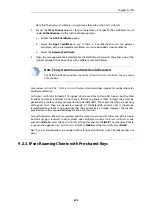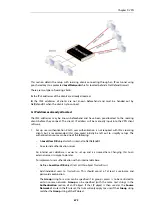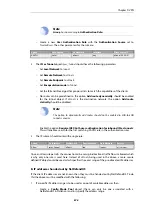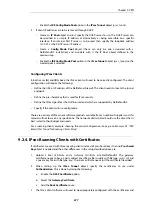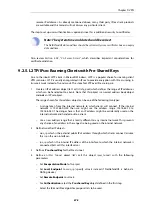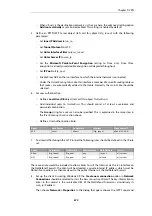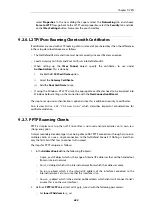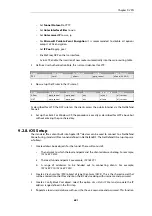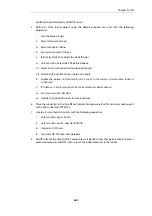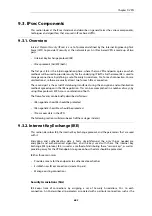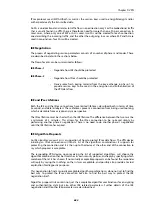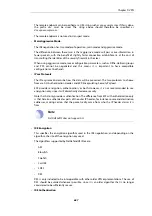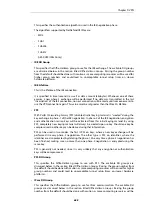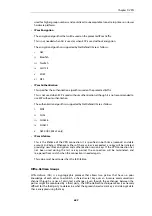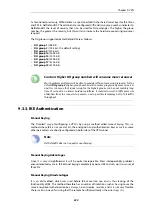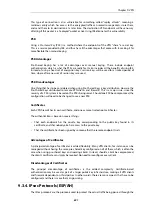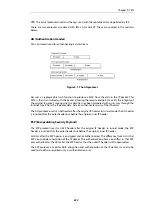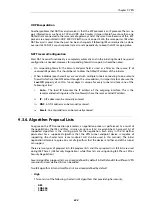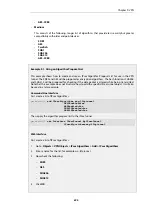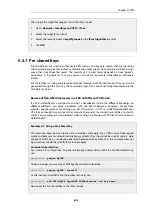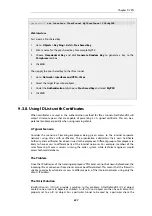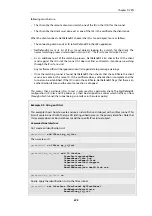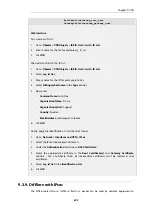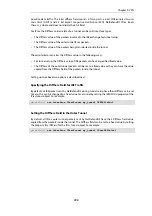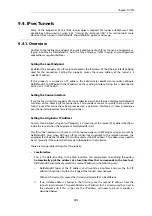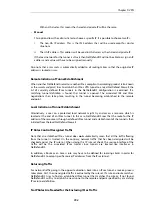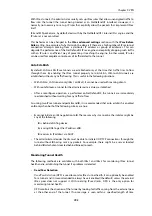
This specifies the authentication algorithms used in the IKE negotiation phase.
The algorithms supported by NetDefendOS IPsec are:
•
MD5
•
SHA1
•
SHA256
•
SHA512
•
AES-XCBC (IKEv2 only)
•
IKE DH Group
This specifies the Diffie-Hellman group to use for the IKE exchange. The available DH groups
are discussed below in the section titled
Diffie-Hellman Groups
. Raising the group number
from the default should be done with caution as more computing resources will be used for
higher group numbers and could lead to unacceptable tunnel setup times on slower
hardware platforms.
•
IKE Lifetime
This is the lifetime of the IKE connection.
It is specified in time (seconds) as well as data amount (kilobytes). Whenever one of these
expires, a new phase-1 exchange will be performed. If no data was transmitted in the last
"incarnation" of the IKE connection, no new connection will be made until someone wants to
use the VPN connection again. This value must be set greater than the IPsec SA lifetime.
•
PFS
With
Perfect Forwarding Secrecy
(PFS) disabled, initial keying material is "created" during the
key exchange in phase-1 of the IKE negotiation. In phase-2 of the IKE negotiation, encryption
and authentication session keys will be extracted from this initial keying material. By using
PFS, completely new keying material will always be created upon re-key. Should one key be
compromised, no other key can be derived using that information.
PFS can be used in two modes: the first is PFS on keys, where a new key exchange will be
performed in every phase-2 negotiation. The other type is PFS on identities, where the
identities are also protected, by deleting the phase-1 SA every time a phase-2 negotiation has
been finished, making sure no more than one phase-2 negotiation is encrypted using the
same key.
PFS is generally not needed, since it is very unlikely that any encryption or authentication
keys will be compromised.
•
PFS DH Group
This specifies the Diffie-Hellman group to use with PFS. The available DH groups are
discussed below in the section titled
Diffie-Hellman Groups
. Raising the group number from
the default should be done with caution as more computing resources will be used for higher
group numbers and could lead to unacceptable tunnel setup times on slower hardware
platforms.
•
IPsec DH Group
This specifies the Diffie-Hellman group to use for IPsec communication. The available DH
groups are discussed below in the section titled
Diffie-Hellman Groups
. Raising the group
number from the default should be done with caution as more computing resources will be
Chapter 9: VPN
688
Summary of Contents for NetDefendOS
Page 30: ...Figure 1 3 Packet Flow Schematic Part III Chapter 1 NetDefendOS Overview 30 ...
Page 32: ...Chapter 1 NetDefendOS Overview 32 ...
Page 144: ...Chapter 2 Management and Maintenance 144 ...
Page 284: ...Chapter 3 Fundamentals 284 ...
Page 392: ...Chapter 4 Routing 392 ...
Page 419: ... Host 2001 DB8 1 MAC 00 90 12 13 14 15 5 Click OK Chapter 5 DHCP Services 419 ...
Page 420: ...Chapter 5 DHCP Services 420 ...
Page 573: ...Chapter 6 Security Mechanisms 573 ...
Page 607: ...Chapter 7 Address Translation 607 ...
Page 666: ...Chapter 8 User Authentication 666 ...
Page 775: ...Chapter 9 VPN 775 ...
Page 819: ...Chapter 10 Traffic Management 819 ...
Page 842: ...Chapter 11 High Availability 842 ...
Page 866: ...Default Enabled Chapter 13 Advanced Settings 866 ...
Page 879: ...Chapter 13 Advanced Settings 879 ...

